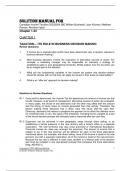Copyright © 2023 McGraw Hill Ltd. Instructor Solutions Manual Chapter One 1 Solution Manual For Canadian Income Taxation 20232024 26E William Buckwold, Joan Kitunen, Matthew Roman, Abraham Iqbal Chapter 1 -23 CHAPTER 1 TAXATION― ITS ROLE IN BUSINESS DECISION MAKING Review Questions 1. If income tax is imposed after profits have been determined, why is taxation relevant to business decision making ? 2. Most business decisions involve the evaluation of alternative courses of action. For example, a marketing manager may be responsible for choosing a strategy for establishing sales in new geographical territories. Briefly explain how t he tax factor can be an integral part of this decision. 3. What are the fundamental variables of the income tax system that decision -makers should be familiar with so that they can apply tax issues to their areas of responsibility? 4. What is an ―after -tax‖ approach to decision making? Solutions to Review Questions R1-1 Once profit is determined, the Income Tax Act determines the amount of income tax that results . However, at all levels of management, alternative courses of action are evaluated . In many cases, the choice of one alternative over the other may affect both the amount and the timing of future taxes on income generated from that activity. Therefore, the person making those decisions has a direct input into future after -tax cash flow. Obviously , decisions that reduce or postpone the payment of tax affect the ultimate return on investment and, in turn, the value of the enterprise. Including the tax variabl e as a part of the formal decision process will ultimately lead to improved after -tax cash flow. R1-2 Expansion can be achieved in new geographic areas through direct selling, or by establishing a formal presence in the new territory with a branch office or a separate corporation. The new territories may also cross provincial or international boundaries. Provincial income tax rates vary amongst the provinces. The amount of income that is subject to tax in the new province will be different for each of the three alternatives mentioned above. For example, with direct selling , none of the income is taxed in the new province, but with a separate corporation , all of the income is taxed in the new province. Because the tax cost is different in each case, taxation is a relevant part of the decision and must be included in any cost -benefit analysis that compares the three alternatives [Reg. 400-402.1]. Copyright © 2023 McGraw Hill Ltd. Instructor Solutions Manual Chapter One 2 R1-3 A basic understanding of the following variables will significantly strengthen a decision maker 's ability to apply tax issues to their area of responsibility. Types of Income - Employment, Business , Property , Capital gains Taxable Entities - Individual s, Corporations , Trusts Alternative Business - Corporation, Proprietorship , Partnership , Limited Structures partnership, Joint arrangement , Income trust Tax Jurisdictions - Federal, Provincial , Foreign R1-4 All cash flow decisions , whether relate d to revenues, expenses, asset acquisitions or divestitures, or debt and equity restructuring, will impact the amount and timing of the tax cost. Therefore, cash flow exists only on an after tax basis , and, the tax impact s whether or not the ultimate result of the decision is successful. An after -tax approach to decision -making requires each decision -maker to think "after -tax" for every decision at the time the decision is being made , and, to consider alternative courses of action to minimize the tax cost, in the same way that decisions are made regarding other types of costs. Failure to apply an after -tax approach at the time that decisions are made may provide inaccurate information for evaluation , and, result in a permanently inefficient tax structure. CHAPTER 2 FUNDAMENTALS OF TAX PLANNING Review Questions 1. ―Tax planning and tax avoidance mean the same thing.‖ Is this statement true? Explain. 2. What distinguishes tax evasion from tax avoidance and tax planning? 3. Does Canada Revenue Agency deal with all tax avoidance activities in the same way? Explain. 4. The purpose of tax planning is to reduce or defer the tax costs associated with financial transactions. What are the general types of tax planning activities? Briefly explain how each of them may reduce or defer the tax cost. 5. ―It is always better to pay tax later rather than sooner.‖ Is this statement true? Explain. Buckwold , Kitunen , Roman and Iqbal , Canadian Income Taxa tion, 2023 -2024 Ed. Copyright © 2023 McGraw -Hill Education Ltd. Instructor Solutions Manual Chapter Three 3 6. When corporate tax rates are 13% and tax rates for individuals are 40%, is it always better for the individual to transfer their business to a corporation? 7. ―As long as all of the income tax rules are known, a tax plan can be developed with certainty.‖ Is this statement true? Explain. 8. What basic skills are required to develop a good tax plan? 9. An entrepreneur is developing a new business venture and is planning to raise equity capital from individual investors. Their advis er indicates that the venture could be structur ed as a corporation (i.e., shares are issued to the investors) or as a limited partnership (i.e., partnership units are sold). Both structures provide limited liability for the investors. Should the entrepreneur consider the tax positions of the individual investors? Explain. Without dealing with specific tax rules, what general tax factors should an investor consider before making an investment? 10. What is a tax avoidance transaction? 11. ―If a transaction (or a series of transactions) that results in a tax benefit was not undertaken primarily for bona fide business, investment, or family purposes, the general anti-avoidance rule will apply and eliminate the tax benefit.‖ Is this statement true? Explain. Buckwold , Kitunen , Roman and Iqbal , Canadian Income Taxa tion, 2023 -2024 Ed. Copyright © 2023 McGraw -Hill Education Ltd. Instructor Solutions Manual Chapter Three 4 Solutions to Review Questions R2-1 There is a distinction between tax planning and tax avoidance. Tax planning is the process of arranging financial transactions in a manner that reduces or defers the tax cost and that arrangement is provided for in the Income Tax Act or is not specifically prohibited. In other words, the arrangement is chosen from a reasonably clear set of options within the Act. In contrast, tax avoidance involves a transaction or series of transactions , the main purpose of which is to avoid or reduce the tax otherwise payable. While each transaction in the process may be legal by itself, the series of transactions cause a result not intended by the tax system. R2-2 Both tax planning and tax avoidance activities clearly present the full facts of each transaction, allowing them to be scrutinized by CRA . In comparison, tax evasion involves knowingly excluding or altering the facts with the intention to deceive. Failing to report an amount of revenue known to exist or deducting a false expense are examples of tax evasion. R2-3 CRA does not deal with all tax avoidance transactions in the same way. In general , CRA attempts to divide tax avoidance transactions between those that are an abuse of the tax system and those that are not. When an action is abusive, CRA will attempt to deny the resulting benefits by applying one of the anti-avoidance rules in the Income Ta x Act . R2-4 There are three general types of tax planning activities: Shifting income from one time-period to another. Transferring income to another entity. Converting the nature of income from one type to another. Shifting income to another time-period can be a benefit if it results in a l ower rate of tax applying to the income . Even if a lower rate of tax is not achieved, a benefit may be gained from delaying the payment of tax to a future time-period. Shifting income to an alternate taxpayer (for example, from an individual to a corporation ) may beneficially alter the amount and timing of the tax. There are several types of income within the tax system such as employment income, business income, capit al gains and so on. Each type of income is governed by a different set of rules. For some types of income , the timing , the amount of income recognized , and the effective tax rate is different from other types. By converting one type of income to another, a benefit may be gained if the timing of income recognition , the amount recognized , and/or the effective tax rate is favorable. R2-5 The statement is not true. Paying tax later may be an advantage because it delays the tax cost and frees up cash for other purposes. However, the delay may result in a higher rate of tax in the future year compared to the current year. In such circumstances , there is a trade -off between the timing of the tax and the amount of tax payable. R2-6 There is not always an advantage to transfer income to a corporation when the corporate tax rate is lower than that of the individual shareholder. While an immediate lower tax rate results, remember that the corporation may be required to distribute some or all of its after-tax income to the shareholder , which causes a second level of tax. Whether or not







